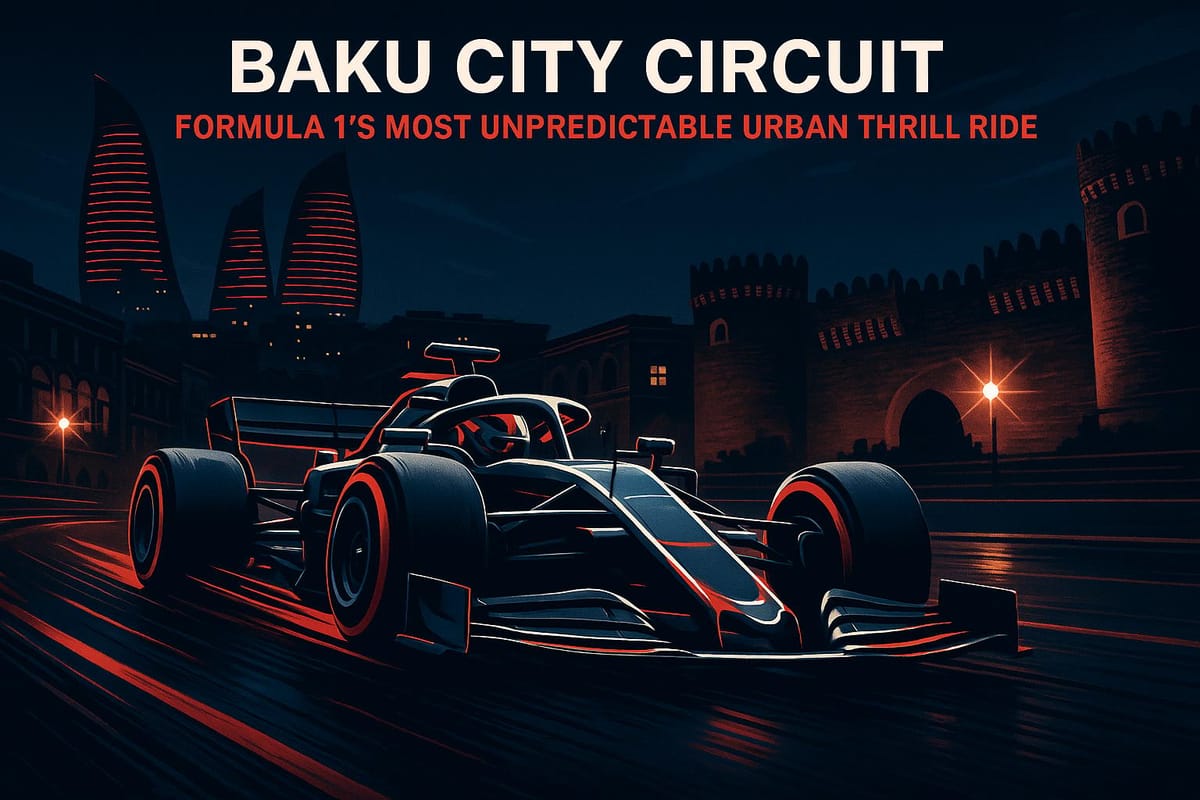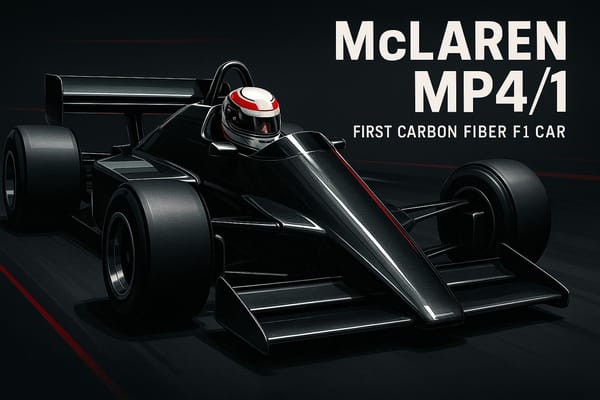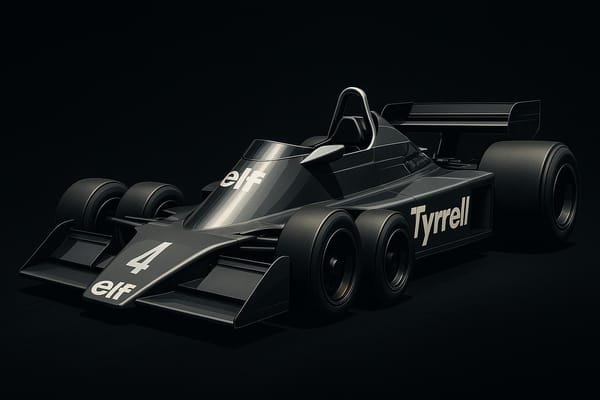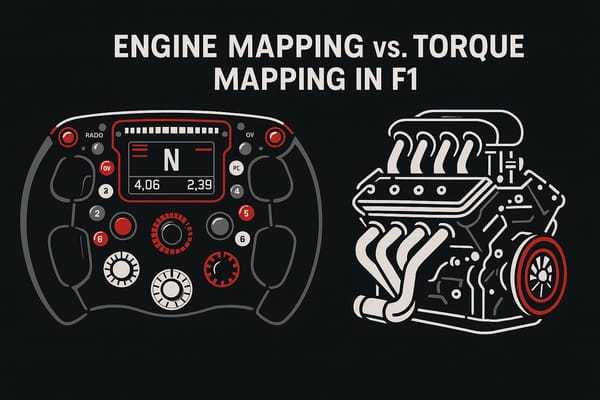Baku City Circuit: Formula 1’s Most Unpredictable Urban Thrill Ride
Explore the thrilling complexity of Baku City Circuit, where high-speed straights meet tight corners, creating an unpredictable racing spectacle.

The Baku City Circuit is one of Formula 1's most challenging and unpredictable tracks. Located in Azerbaijan's capital, this 3.73-mile urban course combines high-speed straights and tight technical corners, creating a unique test for drivers and teams. With speeds exceeding 217 mph on its 1.37-mile straight and a narrow castle section just 25 feet wide, Baku demands precision and adaptability.
Key points:
- Longest straight in F1: 1.37 miles, with top speeds over 217 mph.
- Narrow castle section: Just 25 feet wide, requiring flawless control.
- Unpredictable conditions: Abrasive surface, gusty winds, and frequent safety cars.
- Strategic challenges: Teams must balance low drag for speed with high downforce for control.
From dramatic crashes to surprise wins, Baku has delivered some of F1's most memorable moments since its debut in 2016. This track is where chaos meets strategy, making every race a spectacle.
How to Master the Baku F1 Track! | Nico Rosberg
Track Layout: Speed and Precision Combined
The 6.003 km (3.73 mi) anti-clockwise layout of the Baku City Circuit is no walk in the park. It’s notorious for causing fatigue on the driver's left side while putting extra stress on the right-side tires, forcing teams to make sharp strategic adjustments.
What sets Baku apart is its unique demand for quick transitions between high-speed stretches and tight, technical corners. With 20 turns to navigate, drivers must strike a balance between raw acceleration and precise positioning.
This mix of speed and precision is what makes Baku such a tactical battleground.
"Baku is a great circuit. It's a street circuit, so the risks are doubled, and everything is more complicated because of the proximity to the walls. It's not a circuit where you can be aggressive, take the outside lane on a turn, touch the grass, and have a little dust on the tires." – Pierre Gasly
The circuit's character, blending high-speed sections with technical challenges, forces teams to carefully juggle aggressive setups with tire preservation strategies.
Key Circuit Features
The main straight is Baku’s defining feature. Spanning about 2.2 km (1.4 mi) from Turn 16 to Turn 1, it’s the longest full-throttle stretch on the F1 calendar. Drivers spend 76% of the lap at full throttle, which contributes to some of the season's highest braking energy figures.
With two DRS zones, speeds can exceed 217 mph (350 km/h). However, in 2023, the main DRS zone was shortened by around 100 meters to intensify the challenge of overtaking .
"The trickiest thing in Baku is braking. There's so many braking points where you have to commit and you have to brake as late as you can – but there's no room for error. Once you've committed to that braking point, if you've locked a wheel, you're in the wall." – Daniel Ricciardo
Unlike other street circuits, Baku offers varying track widths that create more overtaking opportunities. Daniel Ricciardo highlights this distinction:
"Baku is different to other street circuits – because there are places where you can pass. Actually, lots of places where you can pass. As opposed to Monaco and Singapore where there's not many places to overtake really." – Daniel Ricciardo
Sector Analysis
Each of Baku’s three sectors presents unique challenges, requiring teams to tailor their car setups and strategies. Here’s a breakdown of the key characteristics:
| Sector | Key Features | Main Challenge | Overtaking Potential | Risk Level |
|---|---|---|---|---|
| Sector 1 | Long straight leading into heavy braking at Turn 1 | Managing tire temperatures and maximizing speed | High – DRS advantage makes it a prime overtaking zone | Medium – Wide runoff areas provide some safety |
| Sector 2 | A mix of corners requiring technical precision | Balancing downforce for turns versus straight-line speed | Low – Limited overtaking opportunities due to layout | High – Close walls and limited escape routes |
| Sector 3 | Narrow castle section with elevation changes | Precision through tight, 7.6-meter-wide passages | Very Low – Too narrow for side-by-side action | Very High – Minimal room for error |
Fuel consumption is another critical factor, with cars burning through approximately 2.1 kg (4.6 lb) per lap. As the fourth-longest circuit on the calendar, Baku pushes engines to their limits. Teams must find a delicate balance between aerodynamic downforce for the technical corners and reduced drag for the long straights. This challenge is further amplified by the anti-clockwise layout, which accelerates tire degradation.
Baku’s intricate design and sector-specific demands make it a true test of both engineering prowess and driver skill.
Race Strategy: Balancing Speed and Control
The Baku City Circuit is one of Formula 1's most challenging tracks when it comes to strategy. Its unique layout features a 1.4-mile straight that demands low downforce for speed, paired with a narrow castle section that requires maximum grip for precision. This duality forces teams to adopt a compromised car setup, sacrificing peak performance in both areas to stay competitive overall.
Teams can’t simply opt for low downforce to gain straight-line speed, as that would leave them struggling in the slower, more technical sectors where tire grip is critical. This balancing act demands constant adjustments and sharp decision-making throughout the weekend.
Aerodynamic Setup and Trade-Offs
Baku presents a tough aerodynamic puzzle. Cars must be configured to hit 217 mph on the straight while also navigating the tight 25-foot-wide castle section. The challenge lies in finding the right balance between reducing drag for speed and generating downforce for stability.
The approach often shifts between qualifying and race day. During qualifying, teams prioritize downforce to maximize cornering grip, while on race day, they lower wing angles to boost straight-line speed. These subtle adjustments can make or break a team’s weekend, influencing whether they contend for a podium or fall out of the points.
Each sector of the circuit demands a specific aerodynamic focus. The first sector, dominated by long straights, rewards low-drag setups. The second sector, with its tight turns near the fortress walls, requires high downforce for control. Finally, the last sector allows teams to cash in on their straight-line speed setup as drivers accelerate for nearly 1.2 miles back to the start/finish line.
Teams that strike the right balance often find themselves in the mix for strong results, while those who miss the mark endure a frustrating weekend, regardless of their car’s potential.
Once the aerodynamic setup is dialed in, attention shifts to another critical factor: tire management.
Tire Management and Pit Stop Strategies
Tire management at Baku centers on controlling rear tire overheating, especially the right rear, which takes the brunt of the circuit’s high-traction demands. The combination of sharp 90-degree corners in the first sector and the prolonged full-throttle stretch in the final sector accelerates tire wear and thermal degradation.
The one-stop strategy is the go-to approach for most teams at Baku. Pirelli consistently identifies this as the fastest option, with teams typically starting on medium tires and switching to hard compounds between laps 14 and 24. Alternatively, some teams opt to start on hard tires and move to mediums between laps 27 and 37.
The 2021 Azerbaijan Grand Prix highlighted the risks of poor tire management when both Lance Stroll and Max Verstappen suffered dramatic tire failures. Pirelli’s investigation revealed that circumferential breaks on the inner sidewalls were caused by specific running conditions, leading to updated monitoring protocols.
"In terms of strategy, on paper, the one‑stop is definitely the quickest option at this track, with medium and hard the most suitable for the 51‑lap race." – Mario Isola, Pirelli director of motorsport
Safety cars add another layer of complexity. With five red flags recorded in FP1 sessions alone, teams must prepare for multiple scenarios. A safety car late in the race can turn a planned one-stop strategy into an opportunistic two-stop, as seen in past races.
"Clearly, a neutralisation could lead to a run of pit stops, as we saw last year, for example. One factor to consider will be graining, given that the track is still very dirty." – Mario Isola, Pirelli director of motorsport
Throughout the race, teams keep a close eye on tire conditions, aiming to balance grip and durability. Tire temperature management is especially critical. If tires run too cold, the rubber stiffens, reducing grip. If they overheat, the compound softens, accelerating wear. Maintaining the optimal temperature window is a constant challenge on a track that demands both high-speed performance and technical precision.
This ability to adapt is key to navigating Baku’s unique mix of speed and control. Teams that master these challenges often find themselves rewarded, while those who falter face a long and grueling race.
Driver Performance: Precision Under Pressure
The Baku City Circuit is a true test of a driver's skill and endurance, where even the smallest error can send a car into the unforgiving barriers. Unlike circuits where drivers can settle into a rhythm, Baku demands constant vigilance and adaptability. The unique challenges of this track are further amplified by grueling physical conditions.
Inside the cockpit, the heat can soar to a scorching 111°F (44°C) during summer races. Add to that the immense forces - up to 5G during braking and cornering - and it’s clear that this isn’t just a mental battle but a physical one too. Drivers can lose as much as 6.6 pounds (3 kg) in sweat during a race, which impacts their concentration and stamina.
Navigating the Castle Section
The Castle Section is one of the most demanding parts of the Baku City Circuit and a true test of precision. At its narrowest point, the track is just 25 feet (7.6 meters) wide. This tight, uphill sequence of Turns 8 to 10 leaves no room for error, with towering fortress walls just inches from the cars.
For Turn 8, drivers must brake just before the 50-meter marker, hugging the outside wall to prepare for the sharp entry. Precision here is everything - focusing on the apex is critical to avoid scraping the barriers. Once through, drivers shift into 4th gear and hold that through the uphill climb of Turns 9 and 10, carefully using every bit of available track. Exiting Turn 9, they must stick close to the left barrier to set up for Turn 11.
Former Renault driver Jolyon Palmer described the challenge perfectly:
"It's all about the braking and, like at any street circuit, there's plenty of time to be gained if you can carry sufficient speed out of the apex – just don't get greedy with the apex and clout the wall."
While the Castle Section is all about threading the needle, the main straight flips the script, turning the focus to high-speed strategy.
High-Speed Slipstream Battles
The long main straight at Baku is where drivers engage in some of the most thrilling overtakes in Formula 1. Slipstreaming - using the reduced air resistance behind another car - is key here. But it’s a delicate balance. Commit too early, and drivers risk misjudging the braking zone into Turn 1. To make matters trickier, the coastal winds in Baku can shift unpredictably, forcing drivers to adapt in real time.
Red Bull’s Sergio Pérez summed up the mental challenge of racing in Baku:
"Baku is all about confidence. It's all about not making mistakes, you know, because here what really can catch you out is making those mistakes and losing track time, starting on the backfoot and you can compromise your weekend fairly easily here. So it's very important to stay out of trouble."
Notable Driver Performances
One of the most jaw-dropping moments in Baku’s history came during the 2017 Azerbaijan Grand Prix. Daniel Ricciardo, then driving for Red Bull, pulled off a stunning three-car overtake on the main straight heading into Turn 1. He passed Nico Hulkenberg in the Renault and both Williams drivers, Felipe Massa and Lance Stroll, in one breathtaking move. Ricciardo’s perfect slipstream positioning and razor-sharp late braking were a masterclass in skill and composure.
This incredible display of driving highlights what makes Baku such a unique challenge: it demands a mix of technical precision, physical endurance, and unshakable focus.
Baku's Place in Formula 1

Baku's reputation in Formula 1 is built on its unpredictable nature and technical demands. Since its debut in 2016, the Baku City Circuit has become a stage for some of the most dramatic and memorable moments in the sport. Its unique combination of high-speed straights and intricate technical sections sets it apart from other urban circuits, delivering a spectacle that keeps fans on the edge of their seats.
Comparing Baku to Other Street Circuits
Baku stands out when compared to other iconic street circuits in Formula 1. Unlike the compact 2.074-mile layout of Monaco, Baku is significantly longer and offers a completely different racing experience. The distinction is best summarized by racing expert Niels van Nistelrooij:
"Monaco has zero margin for error, and almost no chance to overtake. So why bother. Baku has some margin for error and lots of places where you could overtake. When it seems even remotely possible people will try to do so."
Baku also boasts the title of the fastest street circuit, with projected top speeds nearing 220 mph (360 km/h). This forces teams to adopt low-downforce setups to maximize straight-line speed, a stark contrast to the high-downforce configurations required at Monaco and Singapore. The resulting aerodynamic trade-offs mean teams must carefully balance speed with cornering ability, adding another layer of complexity to their strategies.
Rahul Dalal highlights the difference in driver challenges across circuits:
"Monaco and Singapore are a truer test of a Driver's skills cause you can't rest there… and one mistake can cost you a lot. That sometimes is not the case with the Baku circuit, cause you can pull back time on the straight or somewhere."
Singapore, with its stop-start layout and tight 90-degree corners, offers yet another contrast. Both circuits are demanding, but Baku's mix of technical turns and high-speed zones provides more opportunities for overtaking. From a fan perspective, these differences make Baku particularly thrilling. As Dalal puts it:
"From an excitement point of view definitely it is better. It provides more overtakes. More unpredictability with multiple safety cars and that long straight."
This blend of speed, overtaking potential, and unpredictability ensures that no race at Baku follows a predictable script.
Unpredictability and Championship Impact
Baku has earned a reputation as a circuit where anything can happen. Its minimal run-off areas, heavy braking zones, and low-downforce setups create a recipe for chaos. Accidents are common, and safety cars frequently disrupt the race flow, often reshuffling the championship standings in dramatic fashion.
The track's unpredictability forces teams to walk a fine line between aggressive tactics and caution. A single incident can derail a race strategy, making it essential for teams to prepare for a variety of scenarios, from traditional racing to sudden restarts. The multiple safety car periods that have become a hallmark of Baku add another layer of complexity, creating opportunities for bold overtakes and strategic gambles.
Historic Moments at Baku
Since its introduction to the Formula 1 calendar, Baku has delivered countless unforgettable moments. These highlights have solidified its reputation as one of the sport's most thrilling venues:
- 2017: Daniel Ricciardo pulled off an incredible three-car overtake on the main straight, showcasing his exceptional racecraft and securing a stunning victory.
- 2018: Drama unfolded as teammates Max Verstappen and Daniel Ricciardo collided, taking both cars out of the race. The same event saw Romain Grosjean crash under safety car conditions, adding to the chaos.
- 2021: Lewis Hamilton's championship hopes took a hit when he accidentally activated the "brake magic" button, causing him to miss Turn 1 and finish outside the points. Meanwhile, Sergio Perez capitalized on the turmoil to claim his first win with Red Bull.
- 2022: Lance Stroll's crash added to the circuit's growing catalog of dramatic incidents.
These moments highlight just how quickly fortunes can change at Baku. Drivers and teams approach the circuit knowing that a single lapse in focus or an unexpected mechanical issue can have massive consequences for the championship.
Racing enthusiast Ryan Hunt sums up Baku's appeal:
"However, more recently, Baku has become one of my favorites. It's a track set up for the Formula One cars of today. Tight street circuit with plenty of opportunities to pass."
Conclusion: Why Baku Stands Out
The Baku City Circuit has earned its place in Formula 1 as a track that masterfully combines technical complexity with sheer speed. Its design pushes drivers to the limits, requiring pinpoint accuracy through tight corners while also demanding full-throttle performance on its extended straightaways. This dual challenge makes it a proving ground for both driver skill and team engineering.
What sets Baku apart is how its layout creates ample opportunities for overtaking while punishing even the smallest errors. At its narrowest, the track is just 25 feet (7.6 meters) wide, leaving little room for mistakes. At the same time, its long straights encourage thrilling wheel-to-wheel action, where slipstreaming becomes a key tactic.
Success at Baku comes down to finding the perfect balance. Teams that fine-tune their setups to handle the track's unique demands can gain a critical edge, but even the slightest misstep can have significant consequences.
FAQs
Why is the Baku City Circuit considered one of the most challenging tracks in Formula 1?
The Baku City Circuit stands out for its intense combination of high-speed straights and tight urban corners, making it one of the most challenging tracks in Formula 1. On its long straights, drivers can hit speeds rivaling those seen at Monza, but the track also demands navigating corners as narrow as 25 feet. This requires razor-sharp precision and flawless control.
What makes the circuit even more intriguing is its path through Baku's historic center, a designated UNESCO World Heritage site. Drivers face cobblestone sections and uneven surfaces that push both their skills and car setups to the limit. With its unpredictable nature and high-stakes overtaking opportunities, Baku delivers a race that's as thrilling as it is technically demanding.
How do teams manage the aerodynamic challenges of Baku's unique mix of long straights and tight corners?
In Baku, teams face a unique challenge: striking the perfect balance between low downforce for blistering speed on the long straights and high downforce for the grip needed in the circuit's tight, twisting urban sections. To get it right, engineers make precise tweaks to wing angles and overall car setups, ensuring the car performs well in both scenarios.
This balancing act is absolutely crucial. Even the smallest misstep in setup can hurt performance or lead to costly errors on this demanding street circuit. To prepare, teams lean heavily on simulations and past race data, using every tool at their disposal to fine-tune strategies for one of the most unpredictable tracks on the calendar.
What are some unforgettable moments that showcase the unpredictability of the Baku City Circuit in Formula 1?
The Baku City Circuit has earned a reputation for delivering some of the most unpredictable and thrilling moments in Formula 1 history. One of the standout highlights? Daniel Ricciardo's jaw-dropping three-car overtake on the main straight during the 2017 race. It was a gutsy move that perfectly captured the high-speed intensity this circuit is known for.
Then there’s the chaotic 2018 Azerbaijan Grand Prix, a race etched in fans' memories for the dramatic late collision between Red Bull teammates Ricciardo and Max Verstappen. The clash not only shocked viewers but completely altered the race's trajectory, adding another layer of unpredictability to Baku's legacy.
Even the circuit's debut in 2016, when it hosted the European Grand Prix, set the stage for its reputation. With a challenging track layout and surprising results, it pushed drivers and teams to their limits. These moments are exactly why Baku remains one of the most exhilarating and unpredictable stops on the F1 calendar.
Related posts
- Monaco Grand Prix Circuit Guide: The Prestige, Precision, and Pressure of F1’s Crown Jewel
- Albert Park Uncovered: The History, Evolution, and Challenges of the Australian Grand Prix Circuit
- Shanghai International Circuit: A Technical Masterpiece Behind the Chinese Grand Prix
- Suzuka’s Legacy: How Japan’s Iconic Figure-8 Circuit Became a Driver Favourite




